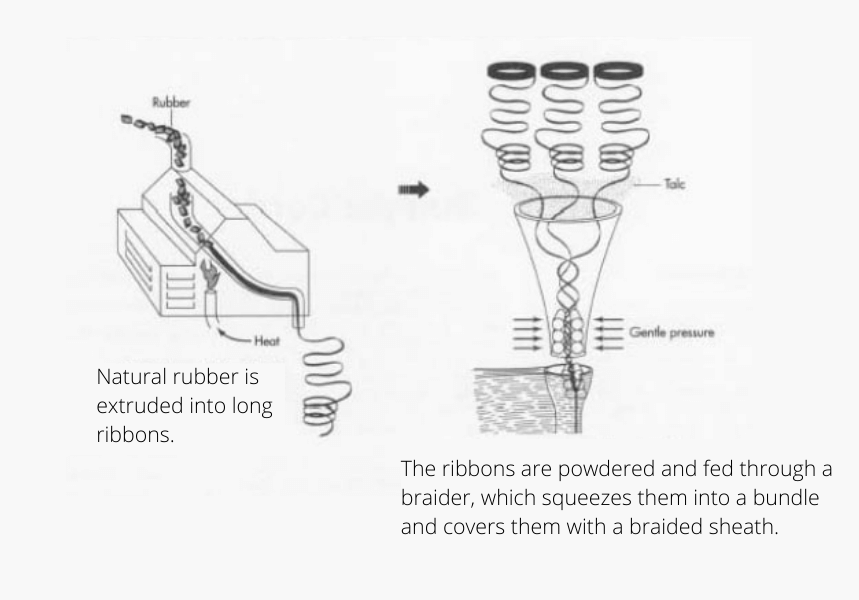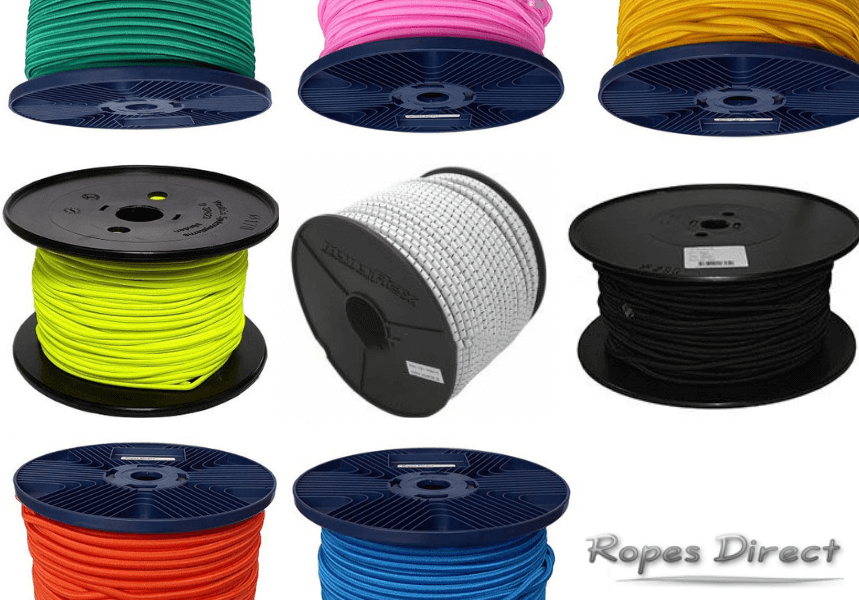Got a question about bungee cords? Well, you’re in luck.
As a leading online supplier, there’s not much we don’t know about this stretchy style of cordage.
Here at RopesDirect, we stock a fantastic range of elasticated bungee cords – with a size, length and colour to meet most needs. And if there’s something you’d like to know before you commit to a purchase, you’re always welcome to get in touch.
Before emailing us though, we recommend reading through the FAQs below. These are the questions we’ve been asked time and time again by previous customers. So the chances are, you’ll get the answers you need – and can have your order completed in no time.
Bungee cord FAQs
What is a bungee cord?
Essentially, a bungee cord (often referred to as a shock cord) is a type of rope, which consists of an elasticated rubber core and a braided outer sheath.
The core can be made from either natural or synthetic rubber. Multiple strands of the rubber are bundled together, then surrounded by a flexible sheath – typically woven from cotton, polypropylene, or nylon. And a fixing, such as a hook end, is applied to one or both ends.
As the cord is stretched, the interior core of elasticated fibres lengthens and builds tension, whilst the braided exterior tightens around the core. This allows it to be used for a myriad of applications, including everything from tying objects down (without a knot) to lifting and towing.
How are bungee cords made?
We won’t get into all the technical details here. But to give you a better idea of their construction, elastic bungee cords are typically made via a three-step process:
Step 1: Extruding – the rubber fibres are first extruded into long ribbons. This is done by placing the rubber into a heated cylinder and forcing it through a small hole (or die) to create the desired shape.
Step 2: Preparing – the individual ribbons are coated with powdered talc or soapstone, to prevent them from sticking together when used outside or in hot temperatures.
Step 3: Braiding – the ribbons are fed through a braiding machine, which squeezes multiple ribbons into a bundle and covers the bundle with a tight weave of yarn. This weave can be any colour and may be patterned for decorative purposes.
Here at RopesDirect, all of our bungee cords are made in Europe by an ISO:9001 registered manufacturer. As such, they’re of exceptional quality and meet the highest specifications. We stock a diverse selection of diameters, ranging from 3 – 16mm, and you can choose from many different weave colours, including solid black, white fleck, neon yellow, red, green, orange, blue and more.

What’s the difference between a bungee cord, shock cord, and elasticated cord?
This is a really easy one to answer – there’s zero difference.
Bungee cord, shock cord, and elasticated cord are three names that are used interchangeably, to describe a cord with a stretchy rubber core and a braided outer sheath. In fact, all of the bungee cords available on our site are actually listed as shock cords, because they’re exactly the same thing!
Having said that, it’s important to note, bungee cords are not the same as bungee straps.
Straps are made from a solid piece of EPDM (ethylene propylene diene monomer) rubber with eyes moulded into each end – through which a hook can be inserted. And whilst they tend to offer more strength than bungee cords, they’re not as elasticated.
What are the properties of a bungee rope?
All of our bungee ropes have either a polyester or polypropylene outer cover and a natural rubber core. And as a result of these materials, they demonstrate many useful properties. For example, they are:
- Stretchy – capable of 100% elongation, they can stretch to double their original length and offer fantastic shock resistance. Perfect for general purpose use. Note – for safety we do not recommend using at maximum stretch.
- Durable – they’re incredibly tough and hard-wearing. Offering excellent resistance to everyday wear and tear, they’re going to last a long time.
- Waterproof – neither the rubber core nor the sheath will be damaged by water. As such, they retain functionality whilst wet and are suitable for prolonged outdoor use.
- UV resistance – whilst polypropylene offers good UV resistance, the UV resistance demonstrated by polyester is very high. An outer sheath made from either of these materials is a good choice for outdoor applications.
- Strength – no matter which diameter you choose, you can expect industry-leading strength and resilience.
What are bungee ropes used for?
Commercially, elasticated bungee cords can be selected as a cost-effective alternative to metal chains – used to lift, move, and lower heavy items and equipment. But most commonly, they’re used to secure objects into place, without having to tie a knot.
For example, they’re often used to hold down:
- sailing boats
- canoes and kayaks
- caravans and camping tents
- car, boat and trailer covers
- roof-racks and curtain-sides
- tarpaulins and trampolines
They can also be surprisingly useful around the home. From child-proofing cabinets and doing your weekly workout to keeping garden furniture firmly on the ground (no matter how windy it gets outside!) – bungee cords can do a lot more than you might imagine!

How far can a bungee cord stretch?
All elastic bungee cords are manufactured to achieve a certain level of stretchiness. This is known as the ‘elongation rating’ and is expressed as a percentage of the cord’s unstretched length.
For example, a 10m bungee cord with a 100% elongation – such as those available at RopesDirect – would stretch to double its original length (20m). Whereas a 10m bungee cord with a 50% elongation would only stretch to around 15m.
Please note, you should never use bungee ropes at their maximum elongation. Not only is this a risk to your safety, the rope will not work as well as it should and is likely to deteriorate very quickly.
To help you choose the right length for your needs, here we’ve created a simple bungee cord size chart – with various rope lengths and their corresponding maximum stretch. But for further information or tailored advice regarding safe elongation, please don’t hesitate to contact our team.
| Length (m) | Elongation | Max stretch (m) |
| 10 | 100% | 20 |
| 20 | 100% | 40 |
| 30 | 100% | 60 |
| 40 | 100% | 80 |
| 50 | 100% | 100 |
| 60 | 100% | 120 |
| 70 | 100% | 140 |
| 80 | 100% | 160 |
| 90 | 100% | 180 |
| 100 | 100% | 200 |
What do I need to consider when buying a bungee cord?
When buying a bungee cord for the first time, be sure to do your research. Not only will picking the wrong product waste your time and money, it can also pose a big health and safety risk. So it’s important to give your purchase some careful consideration.
Ultimately, the key thing that you need to think about is its intended use. How do you plan to use the cord? And with this in mind, you should consider:
- whether it’s for indoor or outdoor use
- how far it will need to stretch
- how strong it needs to be
- whether visibility is important
- which fixings will be required
Detailed information on this topic can be found in our previous blog ‘5 things to consider when choosing bungee cord’ – which is certainly worth checking out. But if you’re still unsure of the best elasticated cords for your needs, you’re welcome to contact us any time. We have in-depth knowledge of the cords available and will happily point you in the right direction.

